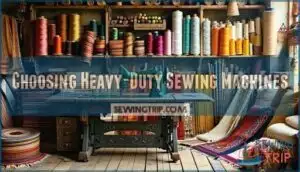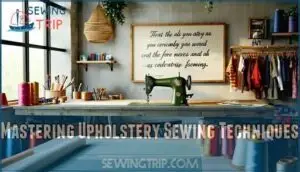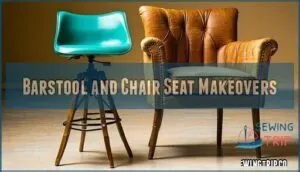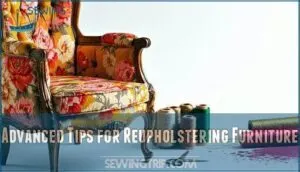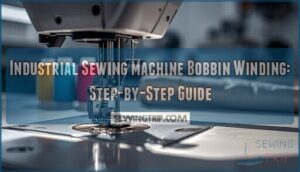This site is supported by our readers. We may earn a commission, at no cost to you, if you purchase through links.
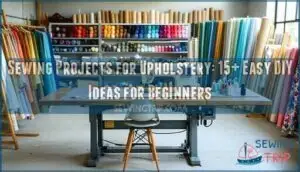 You’ll master sewing projects for upholstery by starting with the right heavy-duty machine and professional-grade materials. Begin with simple cushion covers using fabrics rated for at least 15,000 double rubs, then progress to chair seats and headboards.
You’ll master sewing projects for upholstery by starting with the right heavy-duty machine and professional-grade materials. Begin with simple cushion covers using fabrics rated for at least 15,000 double rubs, then progress to chair seats and headboards.
Your machine needs 1.3+ amps of power to handle thick upholstery materials without breaking needles or creating uneven stitches. Choose reinforced stitching techniques and proper thread tension to prevent puckering.
Smart fabric selection separates amateur results from professional-quality finishes that’ll last decades. The secret lies in understanding which specialized techniques transform ordinary furniture into custom masterpieces worth hundreds more than store-bought alternatives.
Table Of Contents
Key Takeaways
- You’ll need a heavy-duty sewing machine with at least 1.3 amps of power to handle thick upholstery fabrics without breaking needles or creating uneven stitches.
- Choose fabrics with a double rub rating of 15,000+ cycles for moderate use or 30,000+ for high-traffic pieces to ensure your upholstery withstands years of daily wear.
- Start with simple projects like cushion covers and chair seats to master reinforced stitching techniques and proper thread tension before tackling complex furniture restoration.
- Invest in professional-grade tools including size 16-18 upholstery needles, strong polyester thread, and sharp cutting shears to achieve results that rival store-bought alternatives.
Essential Tools for Upholstery Sewing
You’ll need professional-grade equipment to tackle upholstery projects successfully, including heavy-duty machines rated for thick fabrics and specialized needles designed for dense materials.
The right tools make the difference between amateur-looking results and professional-quality finishes that’ll withstand years of use.
Choosing Heavy-Duty Sewing Machines
You’ll frequently find yourself wrestling with lightweight machines that can’t handle heavy-duty fabrics. Machine selection matters—look for motors with at least 1.3 amps of power and variable sewing speed controls.
Industrial sewing machines offer high-quality stitch quality and thread capacity, while heavy-duty sewing machines provide the muscle needed for thick upholstery materials without skipping stitches or jamming.
Selecting Upholstery Needles and Threads
Three needle sizes rule upholstery success: size 16/100 for medium fabrics, 18/110 for heavy materials, and 14/90 for lighter weaves.
Thread Selection matters equally—choose strong polyester or nylon thread with proper thread weight.
Heavy-duty needles prevent breakage while maintaining Stitch Quality. Match Needle Sizes to your fabric’s thickness for ideal Fabric Compatibility and smooth Sewing Machine Settings.
Must-Have Cutting and Measuring Tools
Beyond scissors and shears, you’ll need fabric cutters like rotary cutters and hotknives for precision cuts. Measuring tapes and sewing gauges guarantee accurate dimensions. Cutting mats protect surfaces while rulers guide straight lines.
Quality cutting tools separate amateur from professional results—invest in sharp upholstery shears that’ll slice through thick fabrics like butter.
Picking The Best Upholstery Fabrics
You’ll need fabrics that can handle thousands of hours of use while looking professional throughout your project’s lifespan.
Choose materials with a double rub rating of at least 15,000 cycles for moderate use, or 30,000+ cycles for high-traffic pieces like sofas and chairs.
Understanding Fabric Durability and Double Rub Rating
Double rub rating measures fabric’s abrasion resistance through back-and-forth testing motions. This fabric testing determines wear resistance by simulating real-world use. Higher double rubs indicate stronger durable fabric capable of handling repeated stress.
Look for ratings above 15,000 for household upholstery fabric, while heavyduty fabrics rated 30,000+ suit commercial applications. Understanding fabric durability helps you select materials that withstand your project’s demands.
When choosing fabrics, consider the fabric durability guide to guarantee the best results for your upholstery projects.
Matching Fabric to Project Type
Your fabric selection determines project success. Heavy-duty fabrics work best for high-traffic furniture like sofas and chairs. Lighter indoor upholstery suits decorative pieces.
Consider your project’s purpose: dining chairs need stain-resistant materials, while bedroom headboards can handle delicate textures. Color coordination and pattern mixing create visual impact, but texture choice affects longevity.
Cleaning and Maintenance Considerations
Smart fabric protection creates your upholstery’s first line of defense against daily wear. **Regular dust prevention with gentle vacuuming keeps fibers fresh.
**
You’ll want stain removal solutions for spills, odor control products for pet mishaps, and UV treatments for fade resistance.
Your sewing machine needs proper thread tension and heavy-duty thread to handle ongoing repairs of sewing heavy fabrics. Maintaining your machine ensures longevity.
Mastering Upholstery Sewing Techniques
You’ll master three critical sewing techniques that transform amateur upholstery into professional-grade results: reinforced stitching prevents seam failure, proper needle selection eliminates fabric puckering, and consistent stitch spacing creates perfectly straight lines.
These foundational skills determine whether your upholstery project withstands daily use or falls apart within months.
Sewing Strong Seams and Reinforced Stitches
Strong seams start with proper thread selection and stitch patterns. You’ll need heavy-duty sewing machine settings and consistent fabric tension to create professional results. The backstitch and double stitch provide excellent seam reinforcement for upholstery projects.
- Use strong polyester or nylon thread for maximum durability
- Maintain consistent sewing speed to prevent thread breakage
- Apply backstitch reinforcement at stress points and corners
Preventing Needle Gumming and Puckering
Nobody likes wrestling with a gummed-up needle or watching fabric pucker like it’s having a bad day. Your heavy-duty sewing machine and heavy-duty needles handle thick materials better when needle maintenance becomes routine. Thread tension adjustments prevent that dreaded needle pucker. Clean your needle frequently with rubbing alcohol for gumming solutions. Proper thread selection matches fabric weight, while correct fabric tension reduces needle pucker dramatically.
Heavy-duty needles and proper thread tension prevent gummed needles and fabric puckering in upholstery sewing
| Problem | Solution | Result |
|---|---|---|
| Sticky needle residue | Clean with rubbing alcohol | Smooth penetration through thick upholstery |
| Fabric bunching at seam | Reduce thread tension setting | Flat, professional-looking seams |
| Thread breaks constantly | Match thread weight to fabric | Strong, consistent stitching throughout |
| Needle skips stitches | Replace with fresh sharp needle | Every stitch catches perfectly |
| Uneven fabric feeding | Use walking foot attachment | Both layers move together smoothly |
Achieving Professional-Looking Straight Lines
Your sewing machine’s thread tension and stitch length control can make or break straight line success. Thick upholstery fabrics require higher tension to lift thread properly through layers.
Practice seam alignment on scraps first. Maintaining consistent fabric tension while feeding material helps prevent wandering straight stitches.
Master these straight stitch tips for professional edge finishing results.
Step-by-Step Beginner Upholstery Projects
You’ll start with three straightforward projects that build essential upholstery sewing skills using professional-grade materials and proven techniques.
These step-by-step tutorials guide you through cushion covers, chair seat makeovers, and headboard construction, ensuring you master proper seam reinforcement and fabric handling before tackling more complex furniture restoration.
Simple Cushion Covers and Pillows
Now you’re ready to tackle your first real projects. Cushion covers and pillows offer perfect practice for mastering upholstery fabric handling with your heavy-duty sewing machine. These beginner-friendly projects teach fundamental skills while creating functional home decor.
Here’s your project roadmap:
- Fabric Selection – Choose durable upholstery fabric that matches your room’s style and can withstand regular washing
- Pillow Inserts – Measure carefully and select appropriate cushion filling for desired firmness and comfort
- Zipper Closures – Install invisible zippers using upholstery thread for removable, washable covers
- Tassel Embellishments – Add decorative touches that showcase your growing sewing skills and personal flair
Barstool and Chair Seat Makeovers
Barstool and chair seat makeovers offer perfect practice for upholstery fabric selection and sewing machine techniques. You’ll master frame repair basics while working with manageable pieces.
Choose heavy-duty sewing machine settings for upholstery stitching through thick materials. Focus on fabric durability when selecting patterns – vinyl and canvas work great for high-traffic seats.
These projects teach essential seat restoration skills without overwhelming complexity.
DIY Upholstered Headboards
Creating your own upholstered headboard transforms any bedroom into a designer retreat. Choose headboard shapes that complement your space, then select upholstery fabric with proper fabric durability ratings.
Your heavyduty sewing machine accommodates thick upholstery foam easily. Master DIY tufting techniques and upholstery stitching patterns for professional results.
Experiment with fabric patterns and headboard designs while perfecting sewing machine techniques for lasting upholstery fabric selection success.
Advanced Tips for Reupholstering Furniture
Once you’ve mastered basic upholstery techniques, you’ll need professional-grade materials and precision methods to tackle complex reupholstery projects successfully.
These sophisticated strategies focus on structural reinforcement, fabric grain alignment, and specialized stitching patterns that guarantee your restored furniture withstands decades of use.
Restoring Antique and Vintage Pieces
Bringing new life to inherited heirloom chairs or treasured flea market finds requires thoughtful Heritage Preservation. Vintage Restoration demands era-appropriate Antique Fabric selection—chintz for Victorian pieces, velvet for Art Deco designs. Classic Upholstery techniques use horsehair stuffing and hand-tied springs for authentic Furniture Revival.
Document every step for future collectability, and always test cleaning methods on hidden areas before tackling visible surfaces during your Reupholstery project. Restorers must consider the furniture restoration process to guarantee a successful outcome.
Customizing Fabric and Finishes
Once you’ve mastered restoration techniques, personalizing your piece becomes the exciting part. Fabric selection transforms ordinary furniture into statement pieces that reflect your unique style. Color matching requires understanding undertones – warm or cool hues create different moods in your space.
- Pattern mixing: Combine florals with geometrics using a common color thread
- Texture choices: Pair smooth leather with nubby chenille for visual interest
- Finish techniques: Add decorative welting or contrasting piping for professional edges
- Thread coordination: Match heavy-duty sewing machine thread to dominant fabric colors
- Upholstery fabric layering: Use multiple fabrics on different sections for depth
Ensuring Long-Lasting, Durable Results
Your success hinges on fabric testing and thread selection before you start. Choose heavy duty thread with proper elasticity to handle fabric stretch and withstand daily use.
Use heavyduty sewing machines for seam reinforcement and UV-resistant upholstery fabric. Precision stitching strengthens joints and prevents fraying, creating heavyduty seams that won’t fail under pressure.
These durability factors separate amateur work from professional results.
Frequently Asked Questions (FAQs)
Is sewing in upholstery a good idea?
Sewing transforms, strengthens, and secures your upholstery work. You’ll achieve professional-grade results that last decades. Proper stitching techniques provide durability and clean appearances. It’s absolutely worth learning the skills.
How do you make a good DIY upholstery project?
Start with quality materials and proper tools. **Measure twice, cut once.
**
Choose durable fabric that matches your skill level.
Plan each step carefully, test techniques on scraps first, and don’t rush the process.
Can you sew upholstery without sewing?
Like trying to build without tools, you can’t truly sew upholstery without actually sewing.
You’ll need fabric adhesives, staples, or iron-on tapes as alternatives, but these won’t match sewn seams’ durability and professional finish.
How to make a good upholstery sewing machine?
You can’t make a sewing machine, but you’ll want to choose one with heavy-duty capabilities. Look for machines handling thick fabrics, strong motors, and industrial-grade components for professional upholstery results.
What is a good upholstery project?
Think of grandma’s treasured rocking chair gathering dust—it’s begging for transformation! Experts recommend beginners start with armless dining chairs, headboards, or ottomans to practice essential skills affordably.
How do I get Started in upholstery?
Gather heavy-duty needles, strong thread, and sharp scissors first. Choose a simple project like recovering a small stool. Practice basic stitches on scrap fabric before tackling your furniture piece.
How do you calculate upholstery fabric yardage needed?
Measure each piece from seam to seam, add two inches for seams, then divide by **Add length and width, then divide by 36 to get yardage per piece.
Always order extra for matching patterns.
Whats the difference between webbing and springs?
Approximately 87% of furniture durability depends on the suspension system beneath your upholstery.
Webbing is substantially lighter than traditional metal spring systems, using elastic straps for flexibility, while springs provide firmer, more durable support through coiled metal systems.
Can you reupholster furniture without removing old fabric?
You can reupholster over existing fabric, but it’s not recommended. The added bulk creates uneven surfaces, and old fabric may deteriorate underneath, compromising your investment.
How do you properly stretch and secure fabric?
Pull fabric taut across the frame, starting from the center and working outward. Secure with staples every two inches, maintaining consistent tension to prevent wrinkles or sagging areas.
Conclusion
Ready to transform your living space with professional-quality results? Starting your journey with sewing projects for upholstery doesn’t require years of experience—just the right tools, techniques, and determination.
You’ve learned essential machine requirements, fabric selection criteria, and proven stitching methods that separate amateur attempts from lasting masterpieces. Whether you’re tackling simple cushion covers or ambitious furniture restoration, these foundational skills will serve you well.
Remember, every professional upholsterer started exactly where you’re now, armed with knowledge and ready to create beautiful, durable pieces.
- https://www.sailrite.com/how-to-reupholster-furniture
- https://www.homeyou.com/upholstery-before-after-projects
- https://pmc.ncbi.nlm.nih.gov/articles/PMC9572404/
- https://queenanneupholstery.com/upholstery-stitching-techniques-craftsmanship-that-lasts/
- https://www.alure.com/home-improvements-blog/home-decor/how-much-fabric-do-i-need-for-my-upholstery-project

